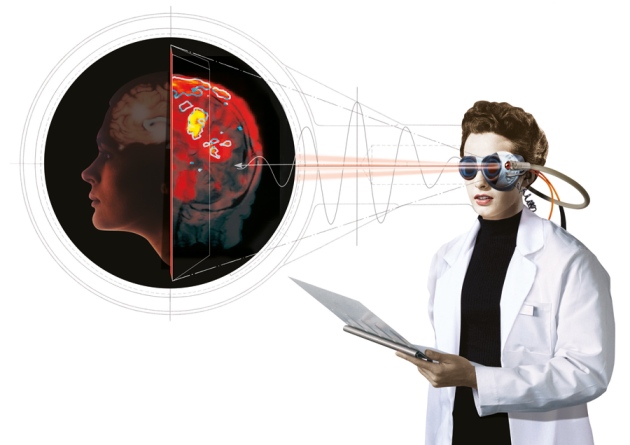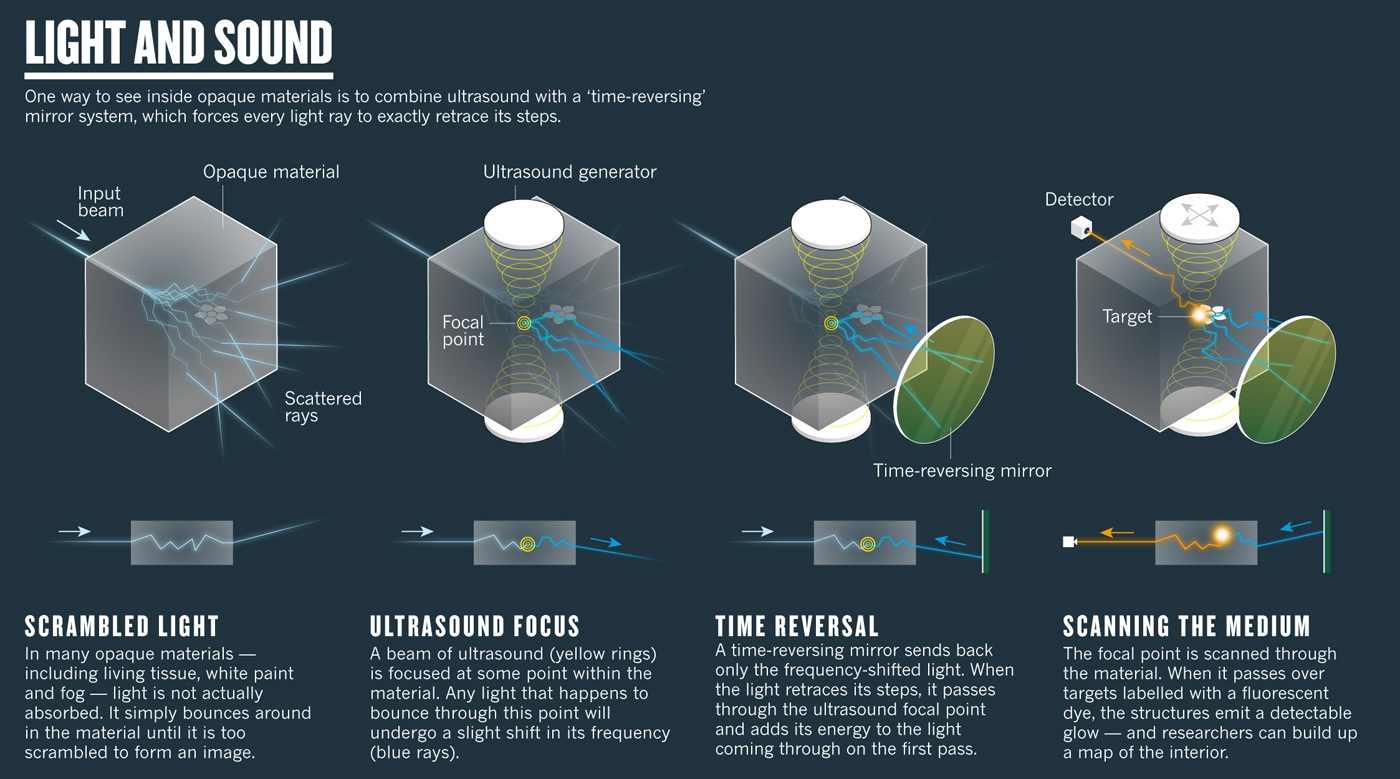2015-03-20 17:36:34
【按】2015为国际光学年, 著名期刊上有很多相关的内容. Optics: Super vision, Nature 518, 158-160 (12 February 2015) doi:10.1038/518158a 就是其中的一篇新闻综述报道. 科学网上有相应的摘译 可见光也能”透视”肉身, 但忽略了一些内容. 我根据原文对红枫原来译文进行了修正和补译, 供感兴趣的人参考.
可见光也能”透视”肉身
科学家欲把天文光学技术用于活体组织透视成像
你可能会说我的想法很疯狂, 但我认为, 我们最终能运用光学技术对整个身体器官进行成像.

It seemed too good to be true, says Allard Mosk. It was 2007, and he was working with Ivo Vellekoop, a student in his group at the University of Twente in Enschede, the Netherlands, to shine a beam of visible light through a ‘solid wall’-a glass slide covered with white paint-and then focus it on the other side. They did not have a particular application in mind. “I really just wanted to try this because it had never been done before,” Mosk says. And in truth, the two researchers did not expect to pick up much more than a faint blur.
听起来似乎好得令人难以置信, Allard Mosk说. 2007年, 身为荷兰特文特大学恩斯赫德分校教授的他和自己团队里的一名学生Ivo Vellekoop一起工作时, 用一束可见光穿透了一面”固体墙”——表面覆盖着白色油漆的载玻片——然后让这些光聚焦在载玻片的另一边. 当时他们对于如何应用这一现象并没有产生确切的想法. “我只是想试一试, 因为之前从没有人这样做过.” Mosk说. 可以说, 当时两位研究人员头脑中除了一点模糊的影子, 并没有其他的想法.
But as it turned out, their very first attempt1 produced a sharp pinprick of light a hundred times brighter than they had hoped for. “This just doesn’t happen on the first day of your experiment,” exclaims Mosk. “We thought we’d made a mistake and there must be a hole in our slide letting the light through!”
然而, 实验结果表明, 他们第一次实验1得到的清晰光斑比他们希望的要亮100倍. “这样的好运你不会一开始实验就撞上.” Mosk吃惊地说. “我们想可能是自己犯了什么错误, 载玻片上一定有一个孔可以让光通过. “
But there was no hole. Instead, their experiment became the first of two independent studies1, 2 that were carried out that year pioneering ways to see through opaque barriers. So far it is still a laboratory exercise. But progress has been rapid. Researchers have now managed to obtain good-quality images through thin tissues such as mouse ears3, and are working on ways to go deeper. And if they can meet the still-daunting challenges, such as dealing with tissues that move or stretch, potential applications abound. Visible-light images obtained from deep within the body might eliminate the need for intrusive biopsies, for example. Or laser light could be focused to treat aneurysms in the brain or target inoperable tumours without the need for surgery.
但载玻片上没有任何孔. 而他们的实验也成为了当年开启”透视”不透明物质的两项独立实验12中的第一项. 到目前为止, 这项工作仍处于实验室阶段, 但相关进展非常迅速. 研究人员现已设法对一些薄的身体组织, 如老鼠耳朵3等进行优质成像, 而且不断进行深入研究. 如果他们可以战胜许多棘手的挑战, 如找到应对活动或是伸展组织的方法, 就会推动其潜在应用. 比如, 如果可以利用从身体组织深层获得的可见光影像, 将不再需要侵入性的活体组织检查; 或者可以在不进行外科手术的情况下, 用激光集中治疗大脑动脉瘤等不宜手术的肿瘤.
“Just ten years ago, we couldn’t imagine high-resolution imaging down to even 1 centimetre in the body with optical light, but now that has now become a reality,” says Lihong Wang, a biomedical engineer at Washington University in St. Louis, Missouri. “Call me crazy, but I believe that we will eventually be doing whole-body imaging with optical light.”
“10年前, 我们甚至难以想象利用光学对身体组织进行精度为1厘米的高分辨率影像成像, 但现在这些已经成为事实.” 美国密苏里州华盛顿大学圣路易斯分校的生物工程学家Lihong Wang说, “你可能会说我的想法很疯狂, 但我认为, 我们最终会用光学技术对整个身体器官进行成像.”
丰富来源 Rich source
It is already possible to peer inside the body with X-rays and ultrasound. But the images produced by such tools are crude compared with those that should be possible with visible light. Partly this is because visible-light images tend to have higher resolution, says Wang. But it is also because optical wavelengths interact strongly with organic molecules, so the reflected light is packed with information about biochemical changes, cellular anomalies and glucose and oxygen levels in the blood.
目前, 已经可以用X射线和超声波窥探到身体内部, 但如果与可见光可能获得的影像相比, 这些手段获取的影像都过于粗糙. Wang表示, 部分原因是可见光影像倾向于拥有更高的分辨率. 但也因为光学波长与有机分子的相互作用更强, 因此反射出的光荷载着生物化学变化, 细胞异常和血液中的葡萄糖, 氧气含量等信息.

However, those interactions also make visible light prone to scattering and absorption. Absorption will scupper any imaging attempt: the information the photons pick up is lost as they are absorbed into the material. Scattering, however, preserves a ray of hope. Many materials, such as skin, white paint or fog, are ‘opaque’ only because photons passing through them ricochet until they are thoroughly scrambled. But they are not lost-so in principle, the scrambling can be reversed.
然而, 这些相互作用也使得可见光易于发生散射与吸收. 吸收会破坏任何企图成像的尝试: 由于光子被材料吸收, 它们携带的信息也会丢失. 然而, 散射仍然保存着一线希望. 很多材料如皮肤, 白色油漆或雾, 都是”不透明”的, 这只是因为光子会弹跳着通过它们直到被完全置乱. 但这些光子没有丢失——因此在原则上, 这种置乱是可逆的.
Astronomers have already solved a version of this scattering problem using a technology called adaptive optics, which allows them to undo the distortions imposed on images of stars, planets and galaxies by the scattering of light in the atmosphere (see Nature 517, 430-432; 2015). The basic idea is to collect light from a bright reference star and use an algorithm to calculate how the atmosphere has smeared and blurred its point-like image. The algorithm then controls a special ‘deformable’ mirror that cancels out the atmospheric distortions, turns the guide-star image into a point, and at the same time brings other distant objects into sharp focus.
天文学家已经使用一种叫作自适应光学的技术解决了这类散射问题中的一个问题, 这让他们可以纠正因大气层中的光散射造成的恒星, 行星和星系图像的变形(参见Nature 517, 430-432; 2015). 其基本思路是从一颗明亮的参考恒星收集光线, 并用一个算法计算大气如何使得恒星的点状图像模糊变形. 这个算法事实上控制着一个特殊的”可变形”的镜子, 用以抵消大气扭曲, 将”吉他”状的恒星图像恢复成点, 同时还能将其他远距离的天体清晰聚焦.
Unfortunately, this technique is tough to use in the body. Targets deep inside biological tissues do not shine the way that stars do-they have to be illuminated from the outside-and the scatterers are much more densely packed than those that scatter light in the atmosphere. “You’d need the equivalent of a deformable mirror with billions of moving parts to compensate for the scattering caused by an egg shell,” says Ori Katz, an optical physicist at the Langevin Institute in Paris. That is why Mosk and Vellekoop were not too hopeful of success when they started. Still, the pair took heart from the advance of technology. “Until recently it had been preposterous to think you could control a million pixels, but, by 2007, every smartphone could do it,” says Mosk.
不幸的是, 这种技术很难在生物体内使用. 生物组织深处目标的闪光方式与恒星不同——必须从外部照亮它们——而且散射体比大气层中光的散射体密集得多. “你需要一个拥有上百亿活动部件的等价的可变形镜子才能补偿一个鸡蛋壳产生的散射.” 法国巴黎劳厄·朗之万研究所的光物理学家Ori Katz说. 这就是Mosk和Vellekoop开始时对成功没有抱太大希望的原因. 然而, 二人依然从技术进步中得到了鼓励. “直到最近, 可以控制一百万像素一直都曾被认为是荒谬的, 但到2007年, 所有的智能手机能做到这一点.” Mosk说.
They therefore made use of a ‘spatial light modulator’: a device similar to an LCD smartphone display that can control the transmission of different parts of a laser beam by delaying one part relative to another. They fired their laser through the modulator towards the painted glass slide, placed a detector beyond the slide and used a computer to monitor how much light the detector picked up. The computer then added and subtracted delays at each pixel of the modulator, going through a process of trial and error to see what changes minimized the scattering of the laser light as it passed through the slide. In effect, it was trying to give the incoming light a distortion that the opaque barrier would exactly cancel out. Mosk and Vellekoop ran the algorithm for more than an hour, and when it was done they had a result that beat all their expectations: a focus that was a thousand times more intense than the background signal1.
他们因此采用了一种”空间光调制器”: 一个与LCD智能手机显示器类似的设备, 通过对激光的一部分相对另一部分进行延迟, 它可以控制一束激光不同部分的传播. 他们通过调制器将激光照向涂了油漆的载玻片, 把一个探测器放在载玻片的另一侧, 并用计算机监测探测器收集到多少光. 然后, 计算机会加上或减掉调制器每个像素的延迟, 通过试错过程, 观察当激光通过载玻片时, 哪些改变会让其散射最小化. 实质上, 它试图对入射光进行扭曲, 以便精确地抵消不透明的屏障. Mosk和Vellekoop将这个算法运行了一个多小时, 当完成后得到了一个完全超出预期的结果: 聚焦的光强是背景信号强度的1000倍1.
“The Mosk experiment was an eye-opener,” says Katz. “It changed the paradigm of what could be done with optical light.”
“Mosk的实验让人大开眼界,” Katz说, “它改变了光学适用的范围模式. “
Soon after his succcess, Mosk learned of similar work being done by bioengineer Changhuei Yang and his team at the California Institute of Technology in Pasadena.
在获得成功之后, Mosk很快了解到帕萨迪纳市加州理工学院的Changhuei Yang与其团队也进行了相似的工作.
These researchers had used a different technique to focus scattered optical light, and a different opaque substance: a thin slice of chicken breast2. But they, too, were surprised by how easy it was to do. “I had thought ‘we’ll spend six months on this, and when it doesn’t work, we’ll chalk it up as a learning experience’,” says Yang. “But actually it wasn’t that hard.”
这些研究人员使用了一种不同的技术来聚焦散射光, 也采用了一种不同的不透明物质: 一片鸡胸切片2. 但实现这种技术的容易程度也同样让他们感到惊讶. “此前我认为, 我们可能要在这项研究上花费6个月, 如果不可行, 我们打算把它作为一次学习经历.” Yang说, “但实际上它并没有那么难.”
Soon after the two papers were published, the field exploded as other physicists rushed to join in. One of them was optical physicist Jacopo Bertolotti, who came to work with Mosk in 2010. Bertolotti, now at the University of Exeter, UK, says that he was drawn both by the “beauty of the experiment” and by the potential it offered for medical imaging. But he could see that that goal was still a long way off.
这两篇论文发表后不久, 随着其他物理学家的迅速介入, 该领域的研究呈现出爆炸式的增长. 光物理学家Jacopo Bertolotti就是其中之一. 曾在2010年加入Mosk的工作团队, 现在英国埃克塞特大学工作的Bertolotti表示, 他为”这项实验的漂亮”及其展现出的医疗成像潜力所吸引, 但是他也表示, 实现这一目标依然有很长的路要走.
The first issue that Bertolotti faced was that Mosk’s original set-up required a camera to be placed behind the opaque surface. That is a problem for medical applications because placing a camera under the skin would involve surgery, which would be invasive, dangerous and rarely worth the risk. In 2012, however, Bertolotti, Mosk and their colleagues devised a way to put both the laser light source and the detector in front of the surface4.
Bertolotti面临的首个问题是, Mosk的原始设备需要将摄像机放置在不透明表面的后面. 对于医疗应用来说这是个问题, 因为在皮肤下放置摄像机需要动手术, 这可能是侵入式的, 危险且存在一定风险. 然而, 在2012年, Bertolotti, Mosk与同事设计了一种把激光源和探测器都放置在载玻片前的方法4.
Their target was a fluorescent Greek letter π just 50 micrometres across hidden behind a thin opaque screen. As such, the target was roughly the same size as a cell and analogous with medical techniques that involved injecting fluorescent dyes into living tissue to aid in imaging. When the laser was switched on, the photons would bounce their way through the screen and produce a diffuse illumination of the fluorescent π. The light reflected from the letter would then make its way back through the screen and produce a blurry speckled pattern on the other side. It was like trying to see the symbol through a shower curtain.
他们的目标是一个仅有50微米大小的荧光希腊字母π, 字母被隐藏在一层不透明薄片之后. 这样, 目标与一个细胞的大小大致相同, 类似于向活体组织注射荧光染料帮助成像的医疗技术. 当打开激光后, 光子会跳跃着通过屏幕, 并使荧光字母π产生一种漫射照明. 从字母反射的光会反向通过屏幕, 并在屏幕的另一面产生模糊的斑点图案. 这就像试图透过浴帘看见符号那样.
Yet the shape of the letter was still encoded in the scattered light. To retrieve that shape, the team recorded the speckle pattern, moved the laser to shine at a different angle, then recorded the new speckle pattern4. By repeating this many times and comparing the patterns point by point, a computer could work out how the patterns were correlated-and from that, work backwards to reconstruct the hidden letter π.
然而, 这个字母的形状依然被编码在散射光中. 为了恢复其形状, 该团队记录了斑点模型, 把激光移动到不同的角度进行照射, 然后记录这些新斑点4. 通过重复这一过程多次, 以及对图案进行点对点的对比, 计算机可以计算出这些图案之间是如何关联的, 并基于此进行逆向运算, 重建隐藏的字母π.
That was progress, says Bertolotti, but it still was not good enough. “It only works if the object to be imaged is on the other side of the scattering medium,” he says. For many medical applications, such as seeing inside the brain, or within a blood vessel, the target is buried within tissue.
Bertolotti表示, 这是一个进步, 却仍然不够理想. “它只有当要成像的物体位于散射介质背面时才起作用.” 他说. 对很多医疗应用来说, 如观察大脑内部或是血管内部, 目标都掩藏在组织内部.
透视内部 Inside out
The challenge of imaging inside the scattering medium has been taken up by a number of groups, including Yang’s and Wang’s. In 2013, for instance, Yang’s team achieved this feat with unprecedented resolution by picking out a fluorescent bead just one micrometre across sandwiched between two artificial opaque layers5.
目前, 已有多个研究组在尝试解决散射介质内部成像这一挑战, 其中就包括Yang和Wang的团队. 例如, 在2013年, 通过识别出放在两片不透明人工薄片之间, 仅有1微米大小的荧光微球, Yang的团队以前所未有的分辨率展示了他们高超的技术5.
Yang, together with biologist Benjamin Judkewitz and the rest of his team did this by illuminating the medium and letting the light bounce its way through to the other side, then reflecting it back with a ‘time-reversing’ mirror, which effectively forces every light ray to exactly retrace its steps. Time-reversing all the rays would simply undo all the scattering, however. So instead, the team focused an ultrasound beam-which is not easily scattered-at one point in the medium, knowing that any optical light that happened to pass through that point would undergo a slight shift in frequency. Then on the far side, the researchers set up the time-reversing mirror tuned so that it would send back only the light that had experienced that frequency shift. The result was a thin, time-reversed beam that would automatically pass back through the focus and add its energy to the light from the first pass. This turned the ultrasound focus into a spot of comparatively high radiation intensity-“a torch inside the wall”, says Judkewitz, who is now at the Charité University Hospital in Berlin. Better still, the ultrasound focus could be moved around within the medium. And when it passed over the bead, the bead fluoresced (see ‘Light and sound’).
Yang, 再加上生物学家Benjamin Judkewitz及其团队成员所采用的方法是, 先对介质进行照明, 让光以弹跳的方式通向另一侧, 再使用时间反转镜将其反射回来, 从而有效地迫使每一束光线精确地回溯其路径. 然而, 对所有光线进行时间反转只会简单地消除所有散射. 因此, 作为替代, 团队将超声波束–它不容易散射–聚焦于介质中的一点, 这样任何通过该点的光其频率都会发生很小的偏移. 然后在另一边, 研究人员设置了时间反转镜, 并将其调整得只能传回那些有频移的光. 结果得到了一个薄的, 时间反转的光束, 它自动通过焦点传回并将其能量添加到第一次通过的光. 这样就将超声聚焦变成了一个具有较高辐射强度的点–“墙中火炬”, 柏林Charité大学附属医院的Judkewitz说. 更好的是, 超声聚焦可在介质中移动. 当它穿过微球时, 微球就会发出荧光(参见”光与声”).
However, the technique was still a long way from seeing into deep layers of tissue, which pose another, much tougher challenge: they tend to move constantly as a result of blood flow and breathing. “We are still not so close to medical applications because these techniques tend to work only if the scattering medium is perfectly frozen in time,” says Mathias Fink, a physicist at Langevin who pioneered a version of the time-reversal technique in the 1990s that used ultrasound alone6. Most groups have reduced the timing from Mosk’s original hour or so to just tens of seconds, says Katz, and that is fine for imaging a bead or a letter π, but not for imaging a tumour in the body.
然而, 这种技术距离观察深层活体组织还有很长的路要走, 这也提出了另一个更加艰难的挑战: 由于血液的流动与呼吸作用, 组织经常处于移动之中. “我们还没有很接近医疗应用, 因为这些技术往往只有当散射介质完全静止时才能起作用,” Mathias Fink说. 他是朗之万研究所的一名物理学家, 曾在上世纪90年代率先提出了仅仅使用超声波的一种时间反转技术6. 大多数研究组都已经将处理时间从Mosk原本的一小时左右减少到几十秒, Katz说, 这对微球或字母π成像是可以的, 但还不适合用于体内肿瘤的成像.
But last year, a team led by Sylvain Gigan, a physicist at the Kastler Brossel Laboratory in Paris, and including Katz and Fink, demonstrated a way to reconstruct the image of the hidden object in just one camera shot7. “It’s a bit like magic when you see the algorithm converge on the final image,” Gigan says. ` 然而在去年, 一个由巴黎卡斯特勒·布罗塞尔实验室物理学家Sylvain Giga领导的团队, 还有Katz和Fink, 展示了一种仅用单次摄影构建隐藏物体影像的方法7. “当看到算法收敛到最终的影像时, 你会觉得有点儿像变魔术.” Gigan说.
Wang agrees that speed is of the essence. “Everything is in motion and we only have a millisecond-scale window to make an image,” he says. In a paper published in January3, Wang and his team managed to get the speed down to 5.6 milliseconds, “which is fast enough for selected in vivo imaging”, he says. Furthermore, their target was made from ink-stained gelatin and sandwiched between the ear of an anaesthetized mouse and a ground-glass diffuser. Getting success with a live mouse is impressive, says Bertolotti-although he points out that “moving from a mouse ear, which is relatively thin, to imaging human skin and flesh will still take a lot of extra work”.
Wang表示, 速度是关键. “一切都在运动, 而我们只有毫秒级别的时间窗口进行成像,” 他说. 在一月份发表的一篇论文中3, Wang及其团队成功地将成像时间缩短到5.6毫秒, “对于体内成像这已经足够快了”, 他说. 此外, 他们的目标用墨水染色的明胶制成, 放置于麻醉小鼠的耳朵和毛玻璃散射器之间. 对活体小鼠取得成功令人印象深刻, Bertolotti说–但他指出, “从相对较薄的小鼠耳朵, 到对人体皮肤和血肉进行成像仍将需要很多的额外工作.”
As of today, Bertolotti adds, there is still no imaging approach that stands out above the rest. Each has its advantages and disadvantages. “Rather than developing one technique that’s good for everything, I think we’ll develop a suite of techniques that could one day all be combined into the same piece of apparatus,” he says. “I don’t know how quickly that might happen, but this is a young and fast-moving community, so it could be within a few years.”
截至今日, Bertolotti补充说, 还没有一种成像方法脱颖而出, 每中方法都有其优点和缺点. “与其开发一种适用于一切的好技术, 我认为我们应该开发一套技术, 所有这些技术有一天可能会被运用到同一个设备中,” 他说. “我不知道这多快会发生, 但这是一个新的, 快速发展的领域, 所以可能在几年之内就会发生.”
The techniques now being pioneered by bioengineers and physicists for medicine could also be put to a range of other purposes. Mosk, for example, believes that these methods could be a tool for art restoration. “Most painters build up works in several layers, and the layers below can influence the chemical and physical ageing of the painting, so it’s of some significance that you know what is in there if you want to preserve it,” he says. Methods that in effect unscatter light could also help the telecommunications industry to unscramble the noise in optical fibres that is caused by scattered light. 生物工程师和物理学家正在开创的这项医学技术也可用于其他领域. 例如, Mosk认为这些方法用于修复艺术品. “大多数画家的作品都有几层, 下面的层可以影响绘画的化学物理老化, 所以如果你想保护这些绘画, 知道下层是些什么非常有意义.” 他说. 实际上非散射光的方法也可以帮助电信行业消除光纤中由散射光导致的噪声.
Another obvious customer is the military, says Fink, who thinks that the technology could be used to allow soldiers to see through a portable shield-either a physical screen or a fogging spray-that obscures them from their enemy’s view. “It’s not the same as being invisible, but it would allow you to see others while not being seen,” he says.
另一个明显的客户是军队, Fink说. 他认为利用该技术士兵可以通过便携式屏蔽看到东西–无论是物理屏幕还是喷雾–但敌人却无法发现他们.” 这与隐形不同, 但它同样可以让你看到别人, 而不被别人发现.” 他说.
Almost all the scientists in this young field get excited when they start dreaming of applications. But Gigan, for one, is keen to keep the applications above board. “When we tell people what we do, someone always asks if we’ll create a phone app to let people look through shower curtains,” he says. “This is something that could be done with our technique-but we don’t intend to do it.”
当开始想象这一技术未来的应用前景时, 几乎所有在这一新领域中工作的科学家都感到兴奋. 不过Gigan, 他们中的一个, 倾向于将该技术用于正当的方面. “当告诉人们我们所做的事情时, 总会有人问, 我们是否会创造一个手机应用程序以便让人能通过浴帘看到里面的东西, “. 他说, “利用我们的技术, 这是可能的–但我们不打算这样做. “
参考文献
-
Vellekoop, I. M. & Mosk, A. P. Phys. Rev. Lett. 101, 120601 (2008). ↩ ↩2 ↩3
-
Yaqoob, Z., Psaltis, D., Feld, M. S. & Yang, C. Nature Photon. 2, 110-115 (2008). ↩ ↩2
-
Judkewitz, B., Wang Y. M., Horstmeyer, R., Mathy, A. & Yang, C. Nature Photon. 7, 300-305 (2013). ↩
-
Cassereau, D. & Fink, M. IEEE Trans. Ultrason. Ferroelectr. Freq. Control 39, 579-592 (1992). ↩
-
Katz, O., Heidmann, P., Fink, M. & Gigan, S. Nature Photon. 8, 784-790 (2014). ↩
